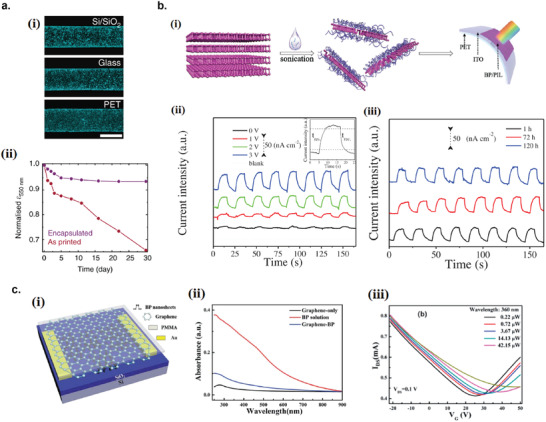Figure 20.

Black phosphorus‐based photodetectors. a) Inkjet printing of liquid‐exfoliated BP. i) Dark field optical micrographs of the optimised printed tracks of BP inks on Si/SiO2, glass and PET. Scale bar: 100 µm. ii) Change in optical extinction (at 550 nm) for encapsulated and unencapsulated printed BP across 30 days under ambient conditions. Reproduced with permission.[ 272 ] Copyright 2017, Springer Nature. b) Conductive polymer ionic liquid (PIL) passivated BP photodetector. i) Schematic illustration of the exfoliation of BP assisted by diluted PIL solution and subsequent photodetector fabrication on a flexible substrate. ii) Photocurrent transients of BP/P([VPIm]TFSI)‐based photodetector under different source–drain bias. Inset graph is the enlarged view of the photocurrent response for rise and decay times. iii) Stability test of the photodetector (1, 72, and 120 h). Reproduced with permission.[ 145 ] Copyright 2018, WILEY‐VCH. c) BP/graphene hybrid photodetector. i) Schematic diagram of the BP/graphene photodetector. ii) UV–vis absorbance spectra of graphene (with PMMA), BP solution, and the BP/graphene hybrid film (with PMMA). iii) Transfer characteristics of the BP/graphene phototransistor under illumination of 360 nm light with different intensities. Reproduced with permission.[ 146 ] Copyright 2020, Royal Society of Chemistry.
